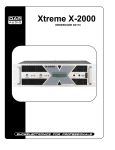Download 2012 SOUTHWEST VIC SOLAR PROJECT
Transcript
2012 SOUTHWEST VIC SOLAR PROJECT FREQUENTLY ASKED QUESTIONS Contents 1 - What is the 2012 SW Vic Solar Project? ............................................................................ 2 2 - What is a solar photovoltaic system, and how does it work? .......................................... 2 3 - What kind of Equipment is being supplied? ..................................................................... 3 4 - Where are the system components made?...................................................................... 3 5 - What kinds of rebates are available to me? ..................................................................... 4 6 - What will happen to rebates in the future? ..................................................................... 5 7 - What size should I purchase?............................................................................................ 6 8 - How long is the system warranted for? ............................................................................ 7 9 - What do I need to do to maintain the system? ................................................................ 7 10 - How well will the system perform? ................................................................................ 8 11 - How much CO2 is used to create the system – how much CO2 will it save me? ........... 9 12 - How much money will the system save or make me?.................................................... 9 13 - Do I need to pay tax on any money that the system earns me? .................................... 9 14 – How can I monitor how well my system is performing?.............................................. 10 15 – Do I still have electricity if there is a Grid power outage? ........................................... 10 16 - Will I need a Smart Meter? ........................................................................................... 10 17 - Will I lose my off-peak or Climate Saver tariff? ............................................................ 11 18 - Will I need a planning permit? ...................................................................................... 11 19 - Once the system is installed, what do I do? ................................................................. 12 20 - How much do the systems cost? .................................................................................. 12 21 - What other costs are there? ......................................................................................... 13 22 - Are the systems customisable?..................................................................................... 14 23- How do I sign up and purchase a system? ..................................................................... 15 24 – Who should I contact?.................................................................................................. 16 KPE Solar PV User Manual Page 1 1 - What is the 2012 SW Vic Solar Project? Portland’s Keppel Prince Engineering is conducting a community solar project in Southwest Victoria to help local households install solar photovoltaic systems before the Victorian Government cuts their Transitional Feed in Tariff (TFiT) in the second half of 2012. Keppel Prince expects to install up to 80 systems before the reduction in the TFiT. This will be run on a strict case of first in has the best opportunity to beat the TFiT reduction. Keppel Prince Engineering employs approximately 400 Glenelg Shire residents, and has been operating in Portland since 1979. Since beginning to install solar systems in 2011, Keppel Prince has installed approximately 700 systems across Victoria, with over 300 in Southwest Victoria. 2 - What is a solar photovoltaic system, and how does it work? Unlike solar hot water systems which take heat from the atmosphere to heat up water, Solar PV systems convert the energy in light into electricity through a conversion reaction which occurs when light strikes the cells in a solar panel. The cells are chemically treated slivers of a silicon crystal which release electrons when exposed to (sun) light. These electrons are ‘captured’ by the thin wires you can see embedded in the panel, from where they are carried to the inverter. It is a relatively simple process that involves no moving parts and should be a reliable source of electricity for you for over 25 years. The PV system’s panels collect electrons in a Direct Current (DC), which is sent to a device known as an inverter that converts the DC electricity into a 240 volt Alternating Current (AC). This is identical to electricity from the Grid, and can be used directly, or sent (sold) to the Grid. As an example: On a clear and sunny day, if a house has a 3kW solar PV system generating at design capacity while the same house has a 1kW microwave oven running and 0.5kW of other assorted appliances, the PV system’s output will be split with 1.5kW used in the house itself, and 1.5kW being sold to the Grid. Conversely, when a solar PV system is not generating electricity and the building requires power, electricity will be drawn from the Grid. KPE Solar PV User Manual Page 2 3 - What kind of Equipment is being supplied? Keppel Prince is supplying systems made up of the following components: • • • • • Monocrystalline Photovoltaic panels. Transformerless solar PV power inverters Aluminium Mounting Frames Matched-metal (with your existing roofing material) or stainless-steel fixtures As-required cabling and switching 4 - Where are the system components made? Panels. KPE’s panels are sourced from one of China’s most modern photovoltaic manufacturers – Sunlink PV, a company that undertakes all of the processes involved “in-house” in a factory that is powered completely by their own 2MW solar PV array. This means your panels have the lowest amount of carbon captured in their manufacture of any in the world. Also, Sunlink is located in Zhangjiagang, which is Portland’s Chinese sister-city. KPE purposefully chose Sunlink as supplier due to the quality of their panels, along with the company’s ethical working conditions and sister-city link, which ensures a solid and long term relationship between the two companies which KPE is proud of. Inverters. KPE sources inverters from Kinglong New Energy Technology (KLNE), a reputable Chinese company with a strong focus on support for their products, which includes an Australian office and service capacity. KLNE has proven to be an excellent supplier who has a strong service and warranty focus. Alternatively, KPE can source SMA inverters from Germany, or Fronius Inverters from Austria if required. SMA in particular are widely used for educational installations as they offer well recognized monitoring equipment which can publish performance data to the internet in real-time. Mounting Frames. The mounting frames supplied with your system are Chinese made, and are designed to withstand wind loads of 60 metres per second (approx. 216kms per hour). Cabling and switching. The cables and isolating switches supplied by installers are all designed specifically to carry either DC or AC currents depending on where they are installed in the system. These components are sourced from multiple suppliers. KPE Solar PV User Manual Page 3 5 - What kinds of rebates are available to me? Small scale solar rebates currently come in two forms: • • An upfront cost reduction rebate known as Solar Credits An ongoing payment for exporting electricity to the Grid know as a Feed in Tariff (FiT) Solar Credits Solar credits are essentially certificates tied to Australia’s Renewable Energy Target, and are sold to liable entities such as coal power station operators. The price of each certificate will fluctuate with market demand. KPE currently pays $39.50 for each certificate generated. This is higher than the current market rate of approximately $26 per certificate. In practical terms, KPE’s purchase of certificates simply reduces the cost of the system, and administers the generation and sale of certificates. There is no action required by you as the solar PV system purchaser. In real terms this equates to a discount of approximately: • • • • • $2,100 from a 1.5kW system $2,450 from a 2kW system $3,150 from a 3kW system $3,850 from a 4kW system $4,550 from a 5kW system Note that the first 1.5kW of an installed system generates twice as much rebate than above this figure. This is because the first 1.5kW is doubled by the Commonwealth Government and is known as the Solar Credit Multiplier. Multiplier table: Nominal Size 0.5 Multiplier $350 Rebate Total $350 1.0 1.5 $350 $350 $350 $350 2.0 2.5 3.0 3.5 4.0 4.5 5.0 $350 $350 $350 $350 $350 $350 $350 $700 $1,400 $2,100 $2,450 $2,800 $3,150 $3,500 $3,850 $4,200 $4,550 Systems are required to be physically installed but are not required to be operating to qualify for Solar Credits. KPE Solar PV User Manual Page 4 Feed in Tariff A FiT is the rate of money you get for of selling electricity back to the Grid, and each State has its own. The current Victorian FiT is called the Transitional Feed in Tariff (TFiT) and is a net-based system, meaning you only get paid for exported surplus. Notes: • • • • The TFiT pays 25c per kWh, but most electricity retailers add a contribution of 6c – 8c so the payment is normally 31c - 33c per kWh. The biggest value of the TFiT is that you effectively get paid the same for exporting surplus energy than you pay from the Grid. This makes energy management very easy. The TFiT is in fact a contract between a solar PV system owner, and the Victorian electrical distribution industry. This contract runs up until the end of 2016 which in most cases will pay off 85% of your solar PV system installation cost. The Vic FiT contracts are based on a total Statewide capacity of 75MW, or approximately 25,000 contracts. These contracts are expected to be fully allocated by the end of September 2012. Systems are required to be physically installed and FULLY operational to qualify for a TFiT contract. 6 - What will happen to rebates in the future? Both the Solar Credits rebate and the Victorian Transitional Feed in Tariff (TFiT) will be reduced in the future on the following timetable and rates. Solar Credits At the end of the 2012-2013 tax year, the multiplier component of Solar Credits will be removed. This will give a real world increase of approximately $1,000 onto all solar PV systems installed after that date. No further reductions are planned after that date while the Commonwealth Government retains the Renewable Energy Target. However, a change of Government and/or a change of policy that reduces or removes the Renewable Energy Target would flow through to solar PV systems, increasing their installed cost by approximately $700 per installed kW. Transitional Feed in Tariff Following the full allocation of TFiT contracts which is expected to occur at the end of September 2012, the Victorian government will not introduce any further payment contract incentives. What is planned instead is the Victorian Government will recommend a “fair” payment from energy retailer and solar PV system owner. The recommended payment is currently being reviewed by the Victorian Competition and Efficiency Commission (VCEC). The expected range will be 6c – 12c in total. Other States have already dropped their FiTs to 8c. KPE Solar PV User Manual Page 5 What this will mean is that large systems exporting surplus power will be unviable, and an emphasis will be to install either: • Systems small enough to never create surplus • Smart Hybrid Systems with battery storage that can automatically store daytime surplus to be used during the night. While KPE feels that this is the way forward, the extra equipment required will increase overall systems costs by $2,000 - $10,000 (depending on size). A key message is that a current TFiT contract is very important for owners of solar PV systems, as it will allow a guaranteed parity return for the next four years, and which time hybrid and battery systems will become more available and affordable. 7 - What size should I purchase? The size of a solar PV system is decided from a number of factors: • Budget • Existing (and predicted) energy consumption • Useable roof space • Motivation (financial, environmental, or varying combinations of both) • Energy consumption habits (Sunlight-hours consumption Vs other consumption) Most households today purchase systems that are between half and all of their overall energy consumption. Typically installed sizes Size Typical scenario 1.5kW Single person or small family with quarterly electricity bills of less than $150 2kW Single person or small family with quarterly electricity bills of approximately $150 3kW Average sized family with quarterly electricity bills of approximately $250 4kW Average sized family with quarterly electricity bills of approximately $400 5kW Average to large sized family with quarterly electricity bills of over $400 Note that while the above table shows typical sizes, actual situations may vary considerably when personal situations are taken into account. KPE expects that mid-term future Victorian solar PV system sizing trends will see smaller systems installed once TFiT contracts are fully allocated and surplus export payments are low. KPE Solar PV User Manual Page 6 8 - How long is the system warranted for? KPE Solar Photovoltaic Small Generating Systems are covered by the following warranties and performance guarantees from the date when installation is completed: • A 5 year warranty against poor workmanship on the installation of your system. This warranty resides with KPE • A 5 year warranty on the Inverter. This warranty resides with the manufacturer through KPE. Contact KPE if you have problems with your inverter and we will arrange a service call on behalf of the inverter manufacturer. KPE has registered your inverter with your manufacturer. • A 5 year warranty against manufacturing defects on the solar PV panels. This warranty resides with the manufacturer through KPE. Contact KPE if you have problems with your panels and we will arrange repair/replacement on behalf of the inverter manufacturer. • A system performance guarantee of 10 year (90% of nominal design capacity) and 25 year (80% of nominal design capacity) measured under standard test conditions from the solar PV panel manufacturers. These guarantees reside with the manufacturer through KPE. Contact KPE if you have problems with system performance and we will arrange appropriate measures on behalf of the panel manufacturer. If test confirm there is a problem, the manufacturer may choose to replace panels or to provide extra panel(s) to bring the overall system performance within the guarantee limits at the time. The decision to install extra panels in this circumstance is made with consent of client. 9 - What do I need to do to maintain the system? Fixed-panel solar PV systems have no moving parts and require very little maintenance. In almost all cases the panels are self-cleaned through normal weather conditions. An annual visual inspection is recommended to check if panels need cleaning and for system damage. A quarterly system performance check via the Inverter’s data output can also be used as an indicator of maintenance requirements. That is, if the system is performing below expectations, cleaning or other maintenance may be required. KPE Solar PV User Manual Page 7 10 - How well will the system perform? Your solar PV system’s performance compared to its rated power capacity can be affected by a number of factors: • • • • • • The amount of solar radiation and ambient temperature on any given day; The deviation of the direction your roof faces away from true north; The inclination (or slope angle) of your roof and/or the panels; Shading of your solar array during peak production times; Efficiency losses in the inverter and system wiring; and/or Mismatched electrical performance of panels in the system. KPE has designed your system wherever possible to minimize the factors which might otherwise cause poorer performance than ought to be achieved: • • • Our panel manufacturers guarantee panel performance of -0/+3 % of rated power; The inverters we use have efficiencies ranging from 95.5% to 98%; and System wiring designs minimize voltage losses in wiring. The effect that angle and orientation will have on your system’s performance is also estimated and noted on the quotation sent to you before you confirmed your purchase. In real terms that should equate to Portland and Hamilton-based north facing systems producing 3.5 – 4.0kWhrs of electricity per day for each installed kW over a 12 month year. Keep in mind that power production will be higher than average during the summer half of the year and lower than average during the winter half of the year. Nominal Size Expected average daily electricity production (kWHrs)* Expected average annual electricity production (kWHrs)* 1520W 5.3 – 6 1,940 – 2,220 2000W 7–8 2,550 – 2,920 3000W 10.5 – 12 3,830 – 4,380 4000W 14 – 16 5,110 – 5,840 5000W 17.5 – 20 6,390 – 7,300 *Where roof is angled away from true north, power production may vary by the solar efficiency nominated on your system quote. KPE Solar PV User Manual Page 8 11 - How much CO2 is used to create the system – how much CO2 will it save me? In most cases, solar PV systems take between 24 and 36 months to generate as much energy as was required to create them, including all components, transport, and installation. In the case of KPE’s Sunlink based systems this is even less, as the manufacture of the panels themselves is powered by an onsite 2MW solar array. Because of this, a reasonable estimate once full system components, transport, and installation are included is 12 – 24 months. In terms of lowering your household’s CO2 footprint, each installed kW will save approximately 1.9 tonnes per year compared to coal powered electricity. Nominal Size Approximate annual CO2 saving compared to coal powered electricity 1520W 2.9 tonnes 2000W 3.8 tonnes 3000W 5.7 tonnes 4000W 7.6 tonnes 5000W 9.5 tonnes 12 - How much money will the system save or make me? With a Transitional Feed in Tariff, this is quite easy and relatively accurate to calculate, as a similar price exists for savings versus selling your surplus to the Grid. Under expected system performance (see #10), the annual amount of savings/earning will be: Nominal Size Approximate financial benefit based on 31c of savings or export sales 1520W $640 - $730 2000W $845 - $965 3000W $1,265 - $1,445 4000W $1,685 - $1,925 5000W $2,105 - $2,4010 13 - Do I need to pay tax on any money that the system earns me? If fitted to a primary residence, no. The Commonwealth Government considers income generated from small solar PV systems on primary residences are not considered to be income, so any profit does not need to be declared and no tax is payable. This also means that the systems are not eligible as a tax deduction, either outright or as a depreciating item. If the system is larger and fitted on a business or investment property, the tax office may regard any profits as income, and depreciation may be available. In this case KPE recommends you seek independent advice from your financial advisor. KPE Solar PV User Manual Page 9 14 – How can I monitor how well my system is performing? The PV System’s Inverter stores data and displays through a digital display on the inverter itself. The data displayed includes: • • • Real-time power generation Daily power generation Total power generation The inverter brands chosen by KPE also have the ability to communicate with most computers as an optional extra purchase. Various third party devices can also measure and report system performance, as well as the building’s energy consumption. 15 – Do I still have electricity if there is a Grid power outage? No. Your solar PV inverter is designed to stop the generation of AC power to your house whenever the main supply grid fails. This is a standard feature of systems so that maintenance workers attempting to fix the grid (or even electricians working on your house wiring) are not exposed to electricity generated locally from your solar PV system. If you require backup power there are two options: • Go off-grid with your solar system • Use a regular power generator 16 - Will I need a Smart Meter? Yes. For Grid connected solar PV systems Smart Meters are mandatory. All Smart Meters are able to be configured to allow solar PV compatibility, but must be programmed to do so. If you already have a Smart Meter, you will still need it reprogrammed for solar. This typically costs $97 to do and is an unavoidable charge. If you do not yet have a Smart Meter, you will have to have one fitted that is programmed for solar PV. In this case the typical cost is $230 for the Smart Meter and $97 for it to be programmed for solar. This is an unavoidable charge. KPE Solar PV User Manual Page 10 17 - Will I lose my off-peak or Climate Saver tariff? Off Peak Tariff If you have an appliance that consumes a lot of night-time electricity such as a traditional electric water system (including Solar Hot Water with electric boost) or have electric slab heating, then you will not lose your off-peak tariff. If you do not have either of those appliances but have an off-peak tariff, you may lose your off-peak tariff. In this circumstance a single rate tariff will probably be more economical for you. Climate Saver Tariff Households with Climate Saver accounts will lose this account in order to obtain a TFiT. In fact, households with Climate Saver accounts need to decommission their Climate Saver meter by having an electrician rewire all of the Climate Saver circuits to the main meter, and requesting Powercor to remove the Climate Saver meter prior to the Solar PV System installation. Circumstances do vary, so KPE recommends that householders contact their energy retailer to confirm. 18 - Will I need a planning permit? No. Planning permits are not required for installing solar PV systems. However, if the building is in a heritage overlay area and the system is to be installed on the street façade of the building, a heritage planning approval may be required. If unsure, KPE recommends querying the statutory planning department of your Council. KPE Solar PV User Manual Page 11 19 - Once the system is installed, what do I do? Once a system is installed, the building owner needs to be proactive to ensure it gets connected to the Grid and to ensure a TFiT contract. This full system installation process is as follows: # Who What 1 CUSTOMER Registers interest (website; phone; email; office visit) 2 KPE Creates Offer and either emails or posts to customer 3 CUSTOMER Signs Offer returned to KPE with deposit 4 KPE Processes Offer and organises site visit & firm quote 5 CUSTOMER Signs Quote returned to KPE with payment 6 KPE Installs PV system 7 KPE 8 KPE 9 10 CUSTOMER Electrical Inspector 11 14 15 16 Signs Solar Connection Form Inspects/approves system installation and signs CES Forwards fully filled in SCF, EWR, CES to retailer, with a copy to Customer Receives copy of the SCF, EWR, CES and forwards EWR to Powercor to provide solar-capable Smart Meter Contact Retailer as a customer to ensure Retailer has received all forms. Installs solar-capable Smart Meter, and informs Retailer Fills out TFiT contract and send to Retailer Puts Customer onto TFiT contract KPE 12 13 Fills in Solar Connection Form (SCF), Electrical Works Request (EWR) & Certificate of Electrical Safety (CES) Requests electrical safety inspection Retailer CUSTOMER Powercor CUSTOMER Retailer Steps 13 and 15 are vitally important for the Customer to perform, as failing to do so may allow the solar PV system application to become lost in the retailer/Powercor system. 20 - How much do the systems cost? For all systems ordered between 1st July - 31st August, prices are as follows: Nominal Size 1520W 2000W 3000W 4000W Actual Panel Capacity System inc design & installation SRET Credit 5000W 8 x 190W panels; 1500W inverter 8 x 250W panels; 2000W inverter 12 x 250W Panels 3000W inverter 18 x 250W Panels 4000W inverter 20 x 250W Panels 5000W inverter $5,692.50 $7,348.00 $10,070.50 $13,230.50 $15,941.50 ($2,093.50) ($2,449.00) ($3,120.50) (3,831.50) (4,542.50) $3,599.00 $4,899.00 $6,950.00 $9,399.00 $11,399.00 ($39.50 inc GST) Net Cost to system buyers All system prices start with ideal conditions, which is a single story steel roof of 15 – 30 degrees where the system panels can be installed in one location and a suitable switchboard is available (see below for details). KPE Solar PV User Manual Page 12 21 - What other costs are there? There are four types of other costs: • Upgrades to your system that you may be required to undertake • Upgrades to your system that you may choose to undertake • Grid connection and switchboard costs • Financing costs Upgrades to your system that you may be required to undertake The following are cost extras which you might expect in the final quotation where your installation is different to the ideal due to roof size, type orientation etc: 1. Tiled Roof: an extra $150 for a 1500W system, $190 for a 2000W system, $260 for a 3000W system, $330 for a 4000W and $360 for a 5000W system; 2. Where available roof is pitched <20o, and you choose a tilted mounting frame: an extra $230 for a 1500W system, $250 for 2000W system, $400 for a 3000W system, $475for 4000W and $550 for 5000W systems; 3. For ground array systems mounted on tilt legs onto concrete foundations supplied by the system owner; an extra $230 for a 1500W system, $250 for 2000W system, $400 for a 3000W system, $475 for a 4000W system and $550 for a 5000W system; 4. DC cabling runs from the panel array to inverter greater than 20m; $20 per extra metre; 5. AC cabling runs from inverter to switchboard greater than 1m; $100 plus $10 per extra metre. This assumes cable runs within the building having solar PV installed. Owners will be responsible for any trenching costs if the preferred installation requires underground cabling from the solar system to switch or meter boards; 6. Extra access costs for double story and/or high shed roofs: an extra $200 for a 1500W system, $250 for a 2000W system, $350 for a 3000W system, $450 for a 4000W system and $500 for a 5000W system; 7. Split array costs of $200 per system where panels have to be installed onto more than one roof space, requiring extra install time and materials: and Upgrades to your system that you may choose to undertake Possible extra equipment you may consider are: 1. Oversize inverter fitted to a 1500W system: 2000W inverter +$200; 3000W inverter + $400; 4000W inverter + $600 and, 5000W inverter + $900. These margins can be extrapolated forwards by subtracting the lower size. For example a 3000W system with a 5000W inverter will cost an extra $500. 2. Battery systems: KPE is currently investigating a range of options for storing energy. These will range from small hybrid Battery/Grid systems; through to fully off-grid systems. Costs will vary considerably. Enquire for further details. 3. Energy monitoring equipment: Prices vary on solution. Enquire for further details. Grid connection and switchboard costs There is a mandatory requirement for all Grid-connected solar PV systems to use an approved solarcapable SmartMeter. This cost may vary for each installation, and is outside the control of KPE. The following are typical SmartMeter costs for houses: 1. Powercor charge to "bring forward" installation of SmartMeter if not already fitted: $96.50 2. Powercor charge to configure SmartMeter for solar PV generation: $227.08 KPE Solar PV User Manual Page 13 Note that if your house does not already have a SmartMeter fitted, you will have to pay both costs. If you already have a SmartMeter you will be required to pay Item 2 ($227.08). If you do not have a suitable switchboard you may be required to upgrade or replace it - or if your solar PV system is fitted to a building (such as a farm shed) without a switchboard you will have to have one installed. In all of these cases this potential work will have to be carried out prior to your solar PV system installation, and is an external cost made between you and the electrician performing that work. KPE will inform you at the quoting stage of the process whether any of this type of work is required. Financing costs Financing costs vary on situation. In most cases, customers source financing from savings. If savings are not available the most common source of financing is either through a home equity loan or a personal loan. 22 - Are the systems customisable? Yes. KPE solar PV systems are customized for every installation, and we will work with you to ensure your system is not only the best choice for today, but also ready for any future needs you may require. KPE Solar PV User Manual Page 14 23- How do I sign up and purchase a system? To sign up for a KPE solar PV system, complete the following: 1. Complete a KPE Offer Document, and return it to Keppel Prince with a base deposit of $1,500 2. Once your deposit is received, KPE will contact you to arrange a site design visit. This visit will confirm the system sizes able to be safely installed onto your property as well as assessing your property for any extra costs above the standard system prices due to the particular circumstances of your property 3. Confirm your final system size you require during the design visit & discussion. 4. KPE will notify you of the final cost of your system (as per the formal KPE Solar Quotation) 5. The outstanding balance of your system cost must be paid as per the timing detailed on the KPE Solar Quotation. We require full payment in advance of installation. 6. On the day the system is installed you will need to be available to sign off documents: • That certifies that the installation has been completed. • That assigns your right to the creation of STC’s for your system to KPE. 7. Once the system has been installed KPE will notify your nominated electricity retailer who will arrange for Powercor to install or configure your meter as required. (See 19 - Once the system is installed, what do I do? for more information.) Notes: • There is a cooling off period of 3 days after the date you receive your final cost confirmation during which time you can decide to pull out of the purchase. • If you take this decision KPE will refund your deposit within 7 days of you notifying us in writing of your decision to not continue. Please include your bank details for an E.F.T. refund • Installations programs may be affected by shipping delays and/or bad weather. KPE will make all reasonable efforts to keep you informed about possible delays to your scheduled installation date. • Failure to sign completion and STC certificates may stop or slow the generation of SRETs for your system and may result in either you being charged an administrative fee or becoming liable for the Gross System Cost and being responsible for sale of the SRET’s yourself. KPE Solar PV User Manual Page 15 24 – Who should I contact? All Portland region questions can be directed to Peter Reefman from Keppel Prince Engineering. Peter Reefman Solar Systems – Projects Coordinator Phone : 03 5523 8843 Mobile : 0408 307 730 Fax : 03 5523 8890 Email : [email protected] Mail : P.O. Box 515, Portland Victoria, 3305 All Hamilton region questions can be directed to Hamilton region coordinator Heinz de Chelard. Heinz de Chelard Hamilton Region Solar Project Coordinator Mobile : 0448 507 374 Email : [email protected] Mail : 236 Mt Baimbridge Rd, Hamilton, Vic 3300 KPE Solar PV User Manual Page 16

































